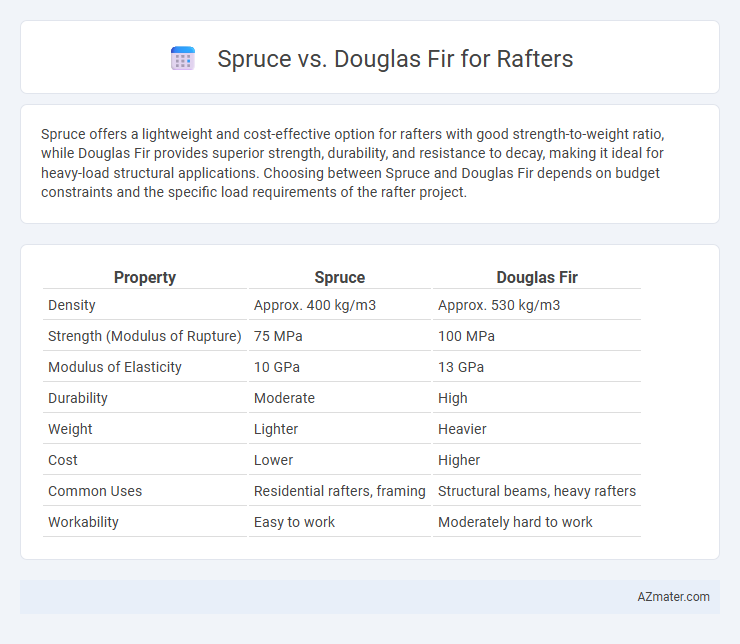Spruce offers a lightweight and cost-effective option for rafters with good strength-to-weight ratio, while Douglas Fir provides superior strength, durability, and resistance to decay, making it ideal for heavy-load structural applications. Choosing between Spruce and Douglas Fir depends on budget constraints and the specific load requirements of the rafter project.
Table of Comparison
| Property | Spruce | Douglas Fir |
|---|---|---|
| Density | Approx. 400 kg/m3 | Approx. 530 kg/m3 |
| Strength (Modulus of Rupture) | 75 MPa | 100 MPa |
| Modulus of Elasticity | 10 GPa | 13 GPa |
| Durability | Moderate | High |
| Weight | Lighter | Heavier |
| Cost | Lower | Higher |
| Common Uses | Residential rafters, framing | Structural beams, heavy rafters |
| Workability | Easy to work | Moderately hard to work |
Introduction: Comparing Spruce and Douglas Fir for Rafters
Spruce and Douglas Fir are both popular choices for rafters due to their strength and workability, with Douglas Fir generally offering higher load-bearing capacity and greater stiffness. Spruce provides a lightweight option with good dimensional stability and is often more cost-effective, making it suitable for a variety of framing applications. Choosing between them depends on specific structural requirements, budget constraints, and local availability for optimal rafter performance.
Overview of Spruce and Douglas Fir Lumber
Spruce lumber is known for its lightweight strength and straight grain, making it a popular choice for rafters where ease of handling and uniformity are important. Douglas fir lumber offers superior structural strength and durability, with tight grain patterns that enhance its load-bearing capacity in roofing applications. Both species provide excellent workability, but Douglas fir is preferred for heavy-duty rafters due to its higher mechanical properties and resistance to warping.
Strength and Structural Integrity
Spruce and Douglas Fir both offer strong performance for rafters, with Douglas Fir exhibiting superior strength and structural integrity due to its higher density and modulus of elasticity, making it ideal for heavy load-bearing applications. Spruce provides reliable strength and is more cost-effective but has a lower weight-bearing capacity and may require larger dimensions to achieve similar performance. For critical rafter installations where durability and resistance to bending stresses are paramount, Douglas Fir is the preferred choice in construction.
Durability and Longevity in Construction
Spruce and Douglas Fir are both popular choices for rafters, with Douglas Fir offering superior durability due to its higher density and natural resistance to decay and insect damage. Douglas Fir rafters typically last longer in construction settings, making them ideal for long-term structural integrity, especially in exposed or load-bearing applications. Spruce rafters, while more affordable, have a shorter lifespan and require additional treatment for enhanced durability in demanding environments.
Weight and Workability
Spruce weighs less than Douglas Fir, making it easier to handle and transport during rafter installation. Douglas Fir offers superior strength but is denser, which can increase the effort required for cutting and fastening. Both woods provide good workability, but Spruce's lighter weight often results in faster, less labor-intensive construction.
Resistance to Decay and Pests
Douglas Fir offers superior resistance to decay and pests compared to Spruce, making it a more durable choice for rafters exposed to moisture and insect activity. Spruce, while lightweight and easy to work with, is more susceptible to rot and termite damage without proper treatment. Selecting Douglas Fir for rafters ensures enhanced structural integrity and longevity in environments prone to decay and pest exposure.
Availability and Cost Considerations
Spruce offers widespread availability and generally lower cost compared to Douglas Fir, making it a budget-friendly option for rafters in many regions. Douglas Fir tends to be more expensive due to its superior strength and durability, but it may not be as readily accessible in certain local markets. Price variations between Spruce and Douglas Fir are influenced by regional supply chains, demand, and the specific grade of lumber selected for rafter construction.
Environmental and Sustainability Factors
Spruce rafters are favored for their rapid growth rate and lower carbon footprint, making them a more sustainable choice compared to Douglas fir, which grows slower and requires longer harvesting cycles. Douglas fir, while durable and strong, often demands more intensive forest management practices that can impact ecosystem balance. Both species are renewable, but spruce's efficiency in growth and regeneration contributes to improved environmental sustainability in construction.
Aesthetic Qualities and Finishes
Spruce rafters exhibit a pale, creamy color with a fine, even grain that accepts stains and finishes smoothly, enhancing modern or minimalist aesthetics. Douglas Fir offers a richer, reddish-brown hue with prominent grain patterns, adding warmth and character ideal for rustic or traditional designs. Both woods respond well to clear finishes, but Douglas Fir's natural coloration often reduces the need for heavy staining.
Final Verdict: Choosing Between Spruce or Douglas Fir for Rafters
Douglas Fir offers superior strength and durability, making it ideal for rafters that require enhanced load-bearing capacity and long-term structural integrity. Spruce is a lighter, more cost-effective option suitable for smaller projects or when budget constraints are a priority. For roofing applications demanding optimal strength and longevity, Douglas Fir is the preferred choice, while Spruce provides adequate performance for less demanding conditions.

Infographic: Spruce vs Douglas Fir for Rafter
 azmater.com
azmater.com